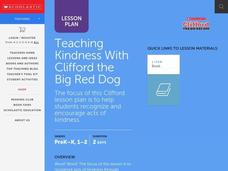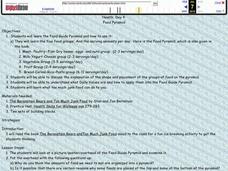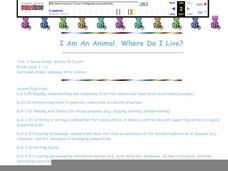Curated OER
Africa - Not Just One Big Safari
Students draw a picture of an African city that includes places similar to those found in U.S. cities. After listening to Somewhere In Africa, students identify places or buildings from the book and apply them to the creation of their...
Curated OER
Native Americans
First graders explore the lifestyles of several North American tribes. They investigate about the homes, food, transportation, and daily living habits of each tribe. Pupils use a map to locate several Native American tribes in North...
Curated OER
Africa - Not Just One Big Safari
Students draw a picture of an African city that is similar to a U.S. city and discover how other parts of the world have the same types of buildings. In this global similarities instructional activity, students create a map of an ...
Curated OER
Story Maps and Boxes
Students use a story map template to review the parts of a story and information about a book that they have read. The elements of the story are identified and placed into story boxes and shared with classmates.
Curated OER
Story Parts
Third graders identify the three major parts of a story. After reading the book "Stellaluna," students discuss the beginning, middle and end of the story. They write a short story depicting the events that would happen if the story...
Curated OER
How Many? How Much?
First graders recognize and learn the value of coins. For this instructional activity on money, 1st graders read the book Monster Money by Grace Maccarone, discuss the role of money in society, identify various coins, and explore making...
Curated OER
The Magic Pot
Students read the story The Magic Pot and complete language arts based activities based on the story. In this language arts lesson plan, students discuss, listen, observe, and complete language worksheets.
Curated OER
Numbers Activity
Students practice identifying quantities of items and materials using numbers. In this counting lesson, students read The Gummi Bear Counting Book by Lindley Boegehold, and utilize a bag of gummy bears as a counting tool. Students...
Curated OER
The Bernstein Bears Celebrate 100 Days of School
In this Bernstein Bears celebrate 100 days of school worksheet, students record what they have learned in 100 days in school. Students list 100 new words, decide how they would spend $100, draw a picture of themselves at 100 years old,...
Curated OER
Chucky Chickadee: Bird and Breakfast Meet the Winter Friends
Learners compare and contrast the attributes of winter birds. In this winter bird lesson, students examine the physical attributes of Black-capped Chickadees, Cardinals, Blue Jays, Flickers, Juncos, Nuthatches, and Tufted Titmouses as...
Curated OER
Soneka's Village
Students read a letter about the characteristics of the Maasai culture. After identifying them, they discuss how to live a pastoralist way of life. In groups, they discuss the roles of men and women in the country and what it might be...
Curated OER
Can You See It?
Fourth graders practice visualizing elements from a story. While reading the poem "One Inch Tall" aloud, the instructor models what they see as they read the passage. Students draw a picture of a scene from the story "Everything on a...
Curated OER
Introduction to Dr. Seuss
First graders look at slides on the SMART Board of different facts about Dr. Seuss and then create a class bar graph of their favorite Dr. Seuss books. In this Dr. Seuss lesson plan, 1st graders review and list facts that they learned...
Curated OER
How Worldly Are You?
Sixth graders locate and map six components to have a working knowledge of maps. In this map skills lesson, 6th graders define the six map components and work in groups to draw a map using the components. Students read a related story...
Curated OER
The Grouchy Ladybug
Students learn about sorting and classifying objects by size while reading Eric Carle's "The Grouchy Ladybug". In this sorting and classifying lesson, students first listen to and interact with the story. They then look at cut-outs of...
Curated OER
Colors, Characters, & Clues: White Socks
Students examine the process of making inferences. They define inference, view a Powerpoint presentation, and as a whole group locate clues in the pictures of a short story, locating written clues to reinforce their conclusions.
Curated OER
Inquiring About the Titanic
Students observe pictures of the Titanic sailing and at the bottom of the ocean. They hypothesize the cause of the Titanic tragedy and engage in deeper questioning while one student writes responses on the board. They then work in groups...
Curated OER
Be Kind
Students express feelings and learn about kindness. In this social skills lesson, students read Clifford Wants a Cookie and retell the story in sequence by using pictures. Students create a sweet treat for someone that has shown them...
Curated OER
Food Pyramid
Students list and explain the five food groups and the recommended serving amounts. In this food pyramid lesson, students discuss the food pyramid and journal about their reaction to it. Students complete a building block activity and...
Curated OER
Lesson Plan: Final Phoneme ll, ff, ss
Young scholars apply word level skills through shared and guided reading.
Curated OER
Children's Literature Across the Curriculum Ideas-Ira Sleeps Over
Students read Ira Sleeps Over by Bernard Waber. They complete a variety of cross-curricular activities surrounding the ideas presented in the story. Included are reading, art, math, science, writing, social studies, and library...
Curated OER
I Am An Animal: Where Do I Live?
Students make an alphabet booklet using the computer to find pictures and facts about farm animals, zoo animals and pets. They write facts about the animals: where they live, what they eat, their coloring, etc.
Curated OER
Philanthropy in Literature Lesson 2: Common Good
Students listen to a number of children's books that describe private citizens participating in acts of kindness, sharing their time, talent or treasure. They identify the characters, problems, and solutions in the books.
Curated OER
What's Hatching in Kindergarten?
Students identify oviparous animals. They brainstorm a list of animals that lay eggs, read "Chickens Aren't The Only Ones" by Ruth Heller and then add to the list. Students complete a booklet that shows an egg and an oviparous animal.

























